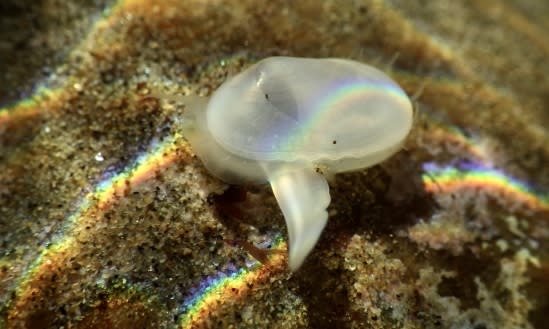'Living fossil' undetected for nearly 30,000 years found in California
In a discovery that can only be described as a 'needle in a haystack,' a clam thought to be extinct for nearly 30,000 years has been found alive in California.
In November 2018, marine researcher Jeff Goddard was searching for slugs at Naples Point when two small, translucent clams caught his eye.
He snapped some high-quality images and shared them with colleagues, who asked him to go back and collect physical samples.
That was easier said than done.
These clams are tiny, with shells measuring only about 10 millimeters. It wasn't until March 2019, after nine unsuccessful trips, that he found another, solitary clam, just as he was about to give up.

A tiny C. cooki clam (bottom center), sitting next to a chiton in the tidepools of Naples Point. (Jeff Goddard).
Back in the lab researchers thought they had a new species - until they checked fossil records. They realized it was an ancient crab whose 28,000-year-old fossil described by George Willett in 1937.
Interesting side note: Willet collected upwards of a million fossil specimens from the area but never found that one particular crab, which he named Bornia cooki -- although it has since been re-classified as Cymatioa cooki. Willet named it after Edna Cook, a collector who owned the only two known fossils.
While Goddard's specimen was in the lab, he struck gold again - finding an empty Cooki shell in the sand.
So how did the clam fly under the radar all this time?

A C. cooki clam found at Naples Point.(Jeff Goddard)
Goddard suspects they were carried north between 2014 and 2016, during a marine heatwave event.
That could explain why there was seemingly no trace of them in the area prior to 2018.
“There is such a long history of shell-collecting and malacology in Southern California — including folks interested in the harder-to-find micro-mollusks — that it's hard to believe no one found even the shells of our little cutie,” Goddard said in a statement.
“The Pacific coast of Baja California has broad intertidal boulder fields that stretch literally for miles, and I suspect that down there Cymatioa cooki is probably living in close association with animals burrowing beneath those boulders.”


